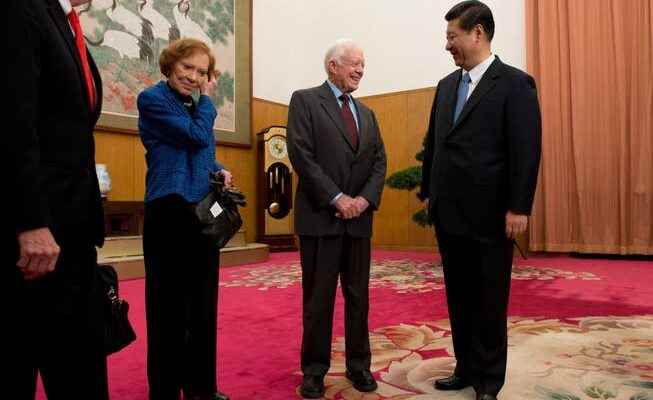A study shows increasing courtship and pressure attempts. But democracies have ways to fight back.
China is also trying to influence public opinion worldwide with incompletely reproduced quotes from prominent visitors. Pictured: Former US President visiting Xi Jinping in Beijing, 2012.
“There is only one China, and Taiwan is part of it,” American President Jimmy Carter said to the cameras in December 1978. The Chinese state newspaper “China Daily” published this video on Tiktok after the visit of the American politician Nancy Pelosi to Taiwan in early August in order to substantiate Beijing’s claim to the democratically governed island. It was, among others, by a spokesman for the Chinese Ministry of Foreign Affairs shared on Twitter.
Although the video is real, it is a skillful manipulation. In context, Carter says: “The United States government recognizes the Chinese position that there is only one China and Taiwan is a part of China.” A clever omission was enough to twist Carter’s testimony.
Beijing is fighting on many fronts in terms of image
This is just one – easily debunked – example of how Beijing is attempting to influence media and public opinion around the world. But the arsenal of Chinese propagandists includes much more than abridged speeches by previous American presidents. The non-governmental organization Freedom House speaks in its latest Report on China’s influence on global media from the fact that Beijing has significantly expanded its activities in the last three years.
During this time, Beijing had to fight on several fronts in terms of image: the outbreak of the coronavirus pandemic in Wuhan and the associated attempts to cover it up, the suppression of the democracy movement in Hong Kong or action against the Uyghurs in Xinjiang – in all of these cases Beijing is trying to find its own to spread the point of view.
Freedom House surveyed 30 countries from the US to Taiwan, from Poland to South Africa, from Chile to Italy. German-speaking countries are not included. In 16 of the countries analyzed, the People’s Republic has expanded its influence since 2019. The Washington-based organization writes that methods for influencing local media narratives and suppressing critical reporting have become more sophisticated, and Beijing is exerting pressure more frequently.
Freedom House identifies six axes of Chinese influence: propaganda, disinformation, censorship and intimidation, control of content distribution infrastructure, training and education for journalists and officials, and the cooptation of media targeting Chinese overseas.
China denies allegations
From a Chinese perspective, there is nothing to the allegations by Freedom House. As is the UN-confirmed persecution of Uyghurs in Xinjiang rejects, Beijing does not see itself as a manipulator of the media in other countries. It is the task of Chinese media and diplomats to convey “the true, multidimensional and panoramic view of China” to the world, said a spokeswoman for the State Department in Beijing. Freedom House accused her of repeatedly making false accusations against China.
Freedom House’s investigation was limited to countries which the organization itself classifies as “free” or “partially free”, thus ruling out authoritarian regimes where the media is tightly controlled. The analysts not only examined the extent of Chinese attempts to influence them, but also how well individual countries are fighting back.
Because there are definitely ways to counter the propaganda from outside. These include laws that disclose the ownership structure of media companies. And it makes a difference whether governments back journalists or human rights activists who are being targeted by the Chinese side.
When media agrees to content-sharing deals with Chinese state media — a popular Beijing tactic — they expose themselves to pressure. As a minimum, they should clearly declare such content and reject it if it is clear misinformation. Doing your own independent research, especially on your country’s bilateral relations with China, is just as important. Social networks such as Twitter or Facebook also play a key role when they clearly identify accounts of Chinese state media or officials.
Taiwan is under pressure – and well prepared
The degree to which individual countries are exposed to China’s attempts at courtship and pressure varies greatly. Countries like the USA, Great Britain and Australia are withstanding the pressure well, but things are looking more difficult in Africa, Latin America and parts of Asia.
The democracy that Freedom House says is under the most Chinese pressure is also the one that is fighting back the most: Taiwan. The common language and the high dependency of the Taiwanese economy on the mainland are weak points; However, the government and the population are very aware of the danger because of the constant threats from Beijing.
In Taiwan there is also a great understanding of how the communist regime in Beijing works and acts. Such background knowledge is needed in order to see through attempts at manipulation – such as President Carter’s abridged speech mentioned at the beginning.
